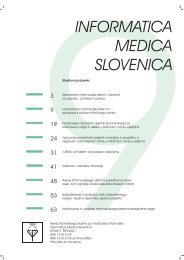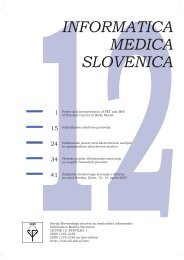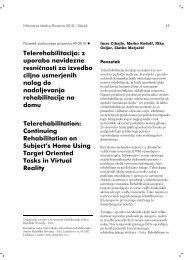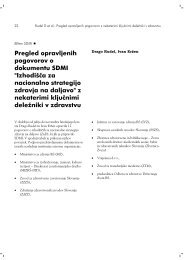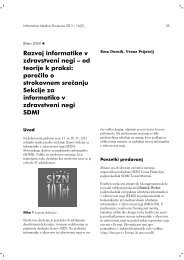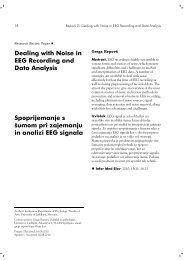INFORMATICA MEDICA SLOVENICA
INFORMATICA MEDICA SLOVENICA
INFORMATICA MEDICA SLOVENICA
- No tags were found...
Create successful ePaper yourself
Turn your PDF publications into a flip-book with our unique Google optimized e-Paper software.
12<br />
Lusa L et al.: Automated Preparation of the Book of Abstracts using R and LaTeX<br />
Methods<br />
Here, we describe how to prepare the files needed<br />
to automatically produce the book of abstracts<br />
with generbook: the set of functions that we wrote<br />
in R language for this purpose and the LaTeX<br />
template for the book of abstracts. The files are<br />
freely available at<br />
http://sites.google.com/site/lara3107/Home/softwar<br />
e/generbook.<br />
To use the package generbook, the users must<br />
download and install R and have on their<br />
computer a program to compile the LaTeX<br />
documents; such programs are available on most<br />
Linux distributions, while Windows and Mac OS<br />
X users can download freely available programs for<br />
this purpose – MikTeX for Windows<br />
(http://www.miktex.org/) or MacTeX for<br />
Mac OS X (http://www.tug.org/mactex/).<br />
Contributions database<br />
The most straightforward way to obtain the<br />
contributions database is by handling the<br />
submission of the contributions using a form<br />
posted on the World Wide Web. Many websites<br />
offer freely available tools for developing and<br />
posting web forms; some examples are the forms<br />
that can be created with Google Docs<br />
(http://docs.google.com, using the forms available<br />
in the Docs spreadsheet), LimeSurvey<br />
(http://www.limesurvey.org) or 1ka<br />
(http://www.1ka.com). Of course, it is possible to<br />
create the database also when more traditional<br />
methods are used for submissions, such as<br />
submissions through electronic or regular mail.<br />
This approach is not very practical if the<br />
contributions database is needed, since the<br />
information about each submission has to be<br />
retrieved and then added manually to the<br />
database.<br />
and abstract) and about the authors (their names,<br />
academic affiliations, contact information, and<br />
indication of which author is going to present the<br />
paper at the conference).<br />
In order to maintain high flexibility in the layout<br />
of the abstracts as they appear in the book of<br />
abstracts, some information must be split in<br />
separate fields. For example, the name of each<br />
author is split into three different fields: first,<br />
middle and last name; similarly, the affiliation of<br />
each author is split into institution, city and<br />
country. Table 1 reports the fields that must<br />
appear in the contributions database for using<br />
generbook.<br />
Two fields can be added to the database after the<br />
submission is complete.<br />
1. A unique identification number (AbstractID)<br />
assigned to each contribution and used in the<br />
program file to uniquely identify them.<br />
2. A variable indicating if the contribution was<br />
accepted for presentation at the conference<br />
(AbstractOK, with value TRUE if the<br />
contribution was accepted, FALSE otherwise)<br />
In order to use the generbook package, the<br />
database has to be in text format with the fields<br />
delimited by tabulation (tab-delimited file). Most<br />
databases can be easily exported into such format.<br />
The user can choose any name for the fields in the<br />
original database, as they do not need to have prespecified<br />
names.<br />
The package generbook can be used together with a<br />
contributions database in which each contribution<br />
represents a record in the database. The records<br />
contain information about the contribution (title



